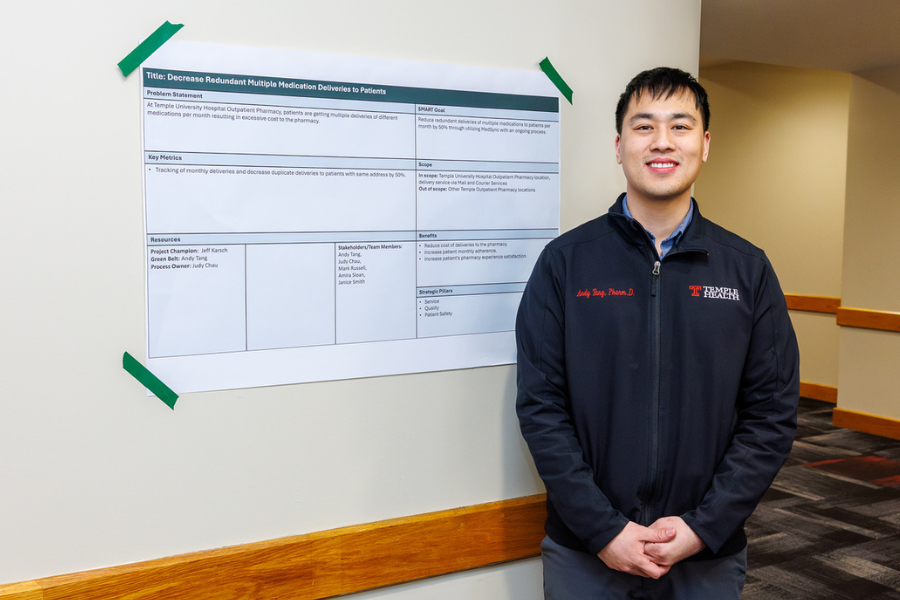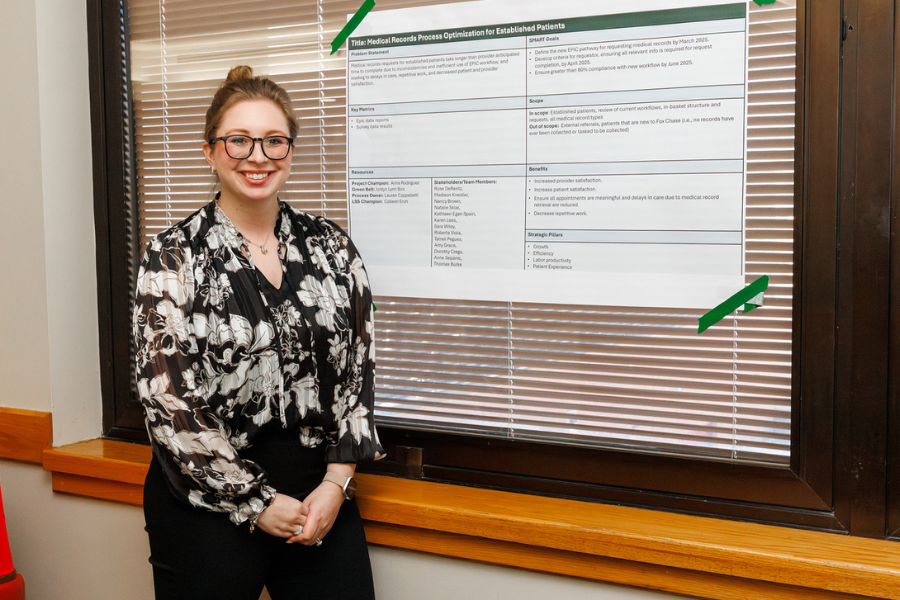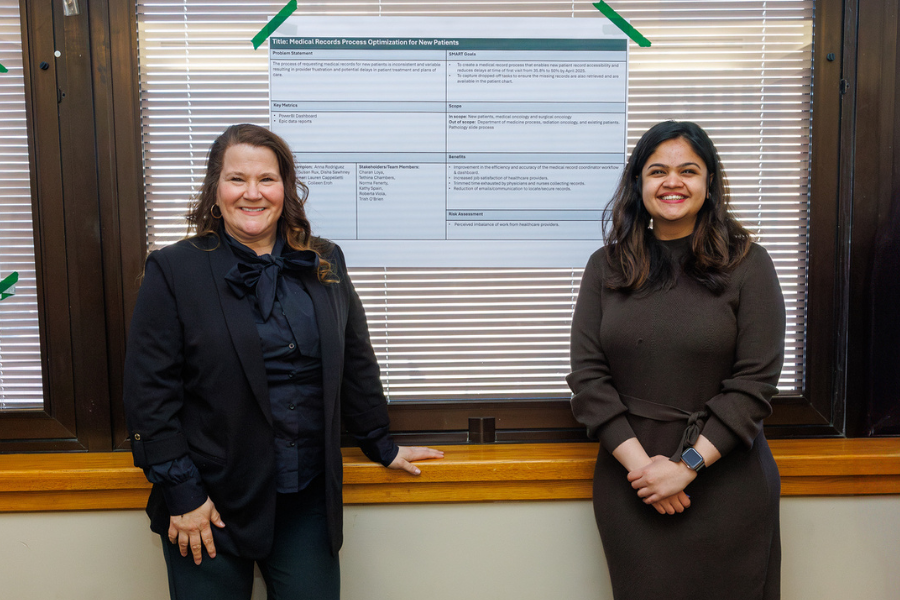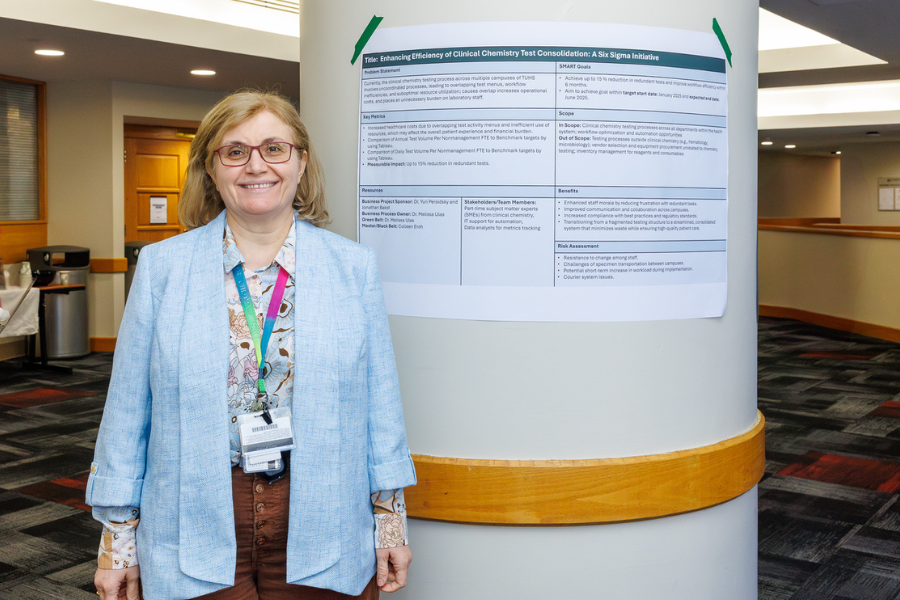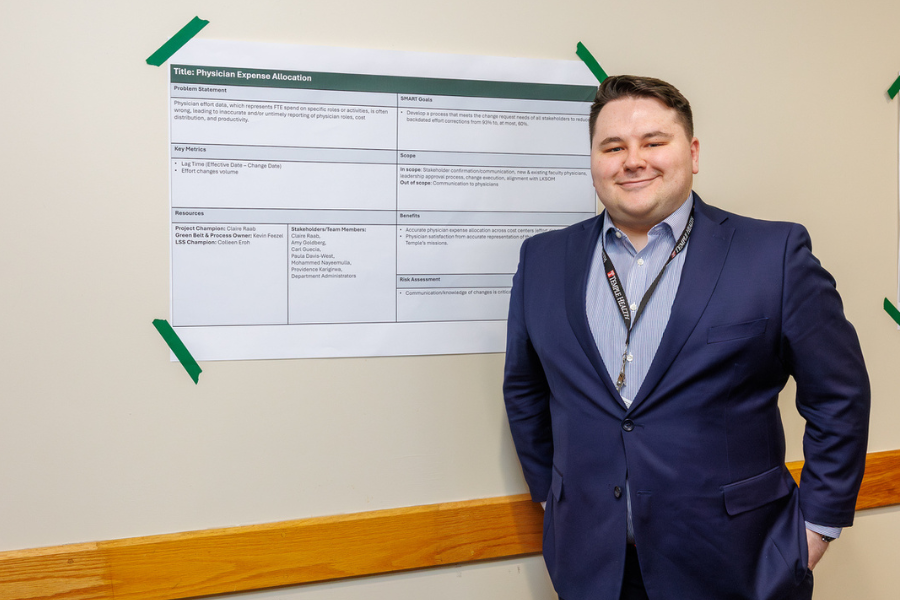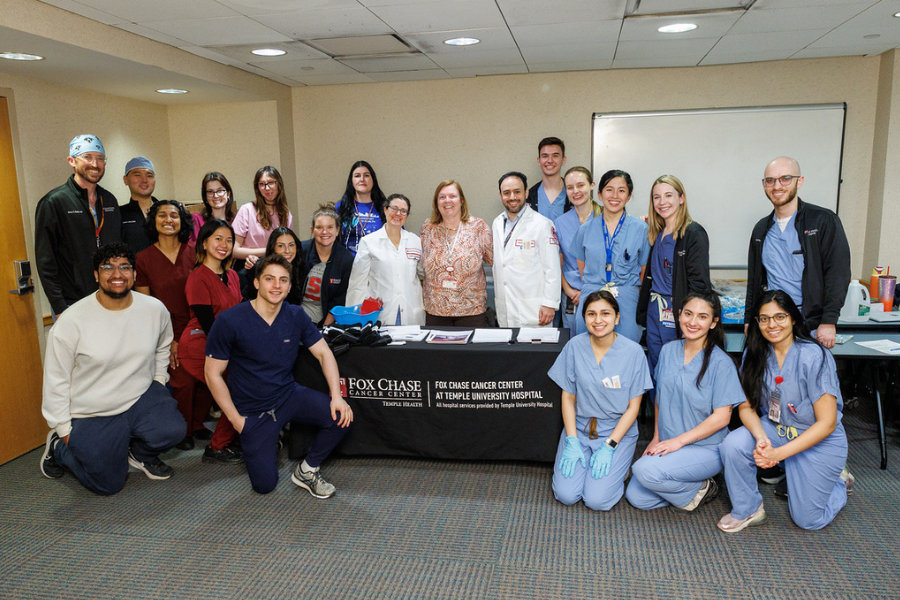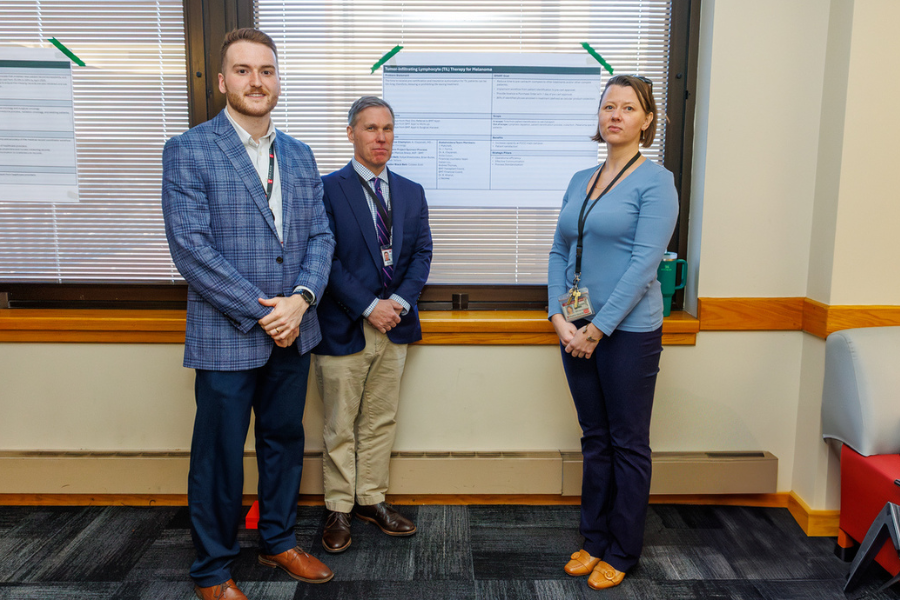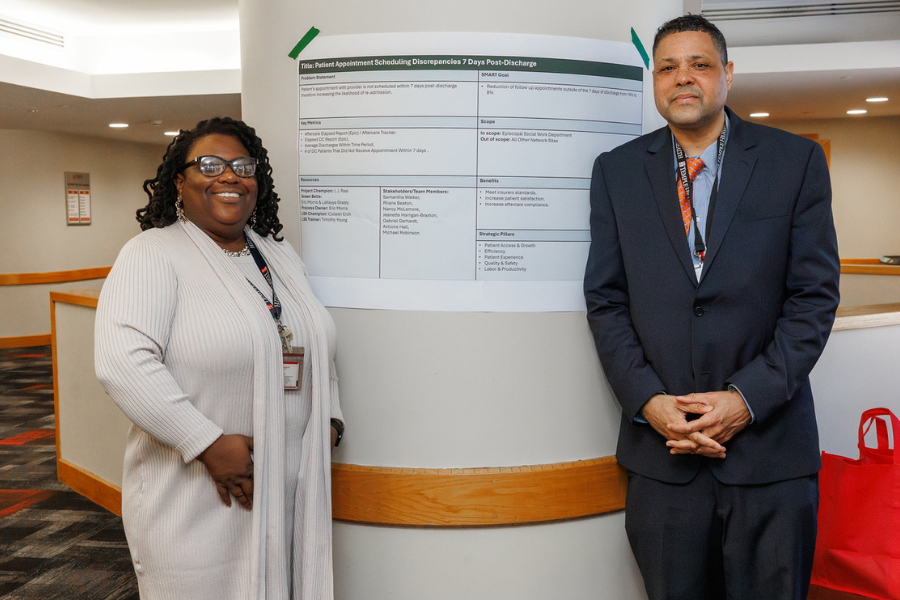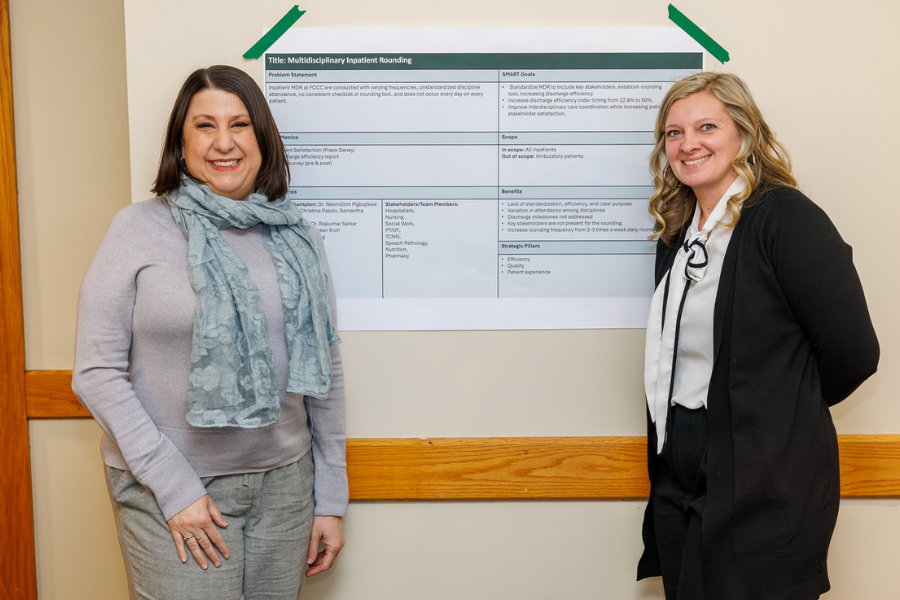What do the Lean Six Sigma Green Belt program and Temple Health have in common? They’re both dedicated to delivering the very best outcomes and the highest satisfaction rates by improving quality and efficiency and reducing waste and cost.
That’s why Green Belt is a perfect fit for our Health System—and why we just celebrated our first cohort graduating from the program and achieving their certification.
“At the core of Green Belt is what’s called the DMAIC (Define, Measure, Analyze, Improve, and Control) process,” says Colleen Eroh, Director of Service Line Operations at Fox Chase Cancer Center, who led the effort to bring the program to Temple Health and, as a Six Sigma Black Belt graduate, was certified to coach the inaugural cohort.
“It’s designed to help you identify the problem and, rather than rushing to find a solution, to undercover the ‘why?’ behind what’s happening,” Eroh continues. “That way, we can set appropriate goals, identify potential roadblocks, and develop and implement process improvement strategies that will work long-term.”
“Applying the DMAIC process helps us break out of the ‘we’ve always done it that way’ mentality,” says Director of Organizational Development Tanya O’Neill, BSN, PsyD, CPC, who negotiated the Green Belt program agreement with Temple’s Fox School of Business. “Sometimes, we become so familiar with our established processes that we don’t realize we’re being inefficient, and that there’s a better way to do things.”
Making Green Belt Part of Temple Health
The effort to bring Green Belt to Temple Health started with the success of the Yellow Belt program—a lower-level Six Sigma initiative—at Fox Chase Cancer Center.
“Colleen saw how well the Yellow Belt program was working, and proposed that we add Green Belt as well,” O’Neill explains. “She thought it would help us develop a more systematic, metrics-based approach to increasing quality and efficiency, as well as boosting our employee engagement and retention and patient satisfaction rates.”
O’Neill and her team reached out to our Yellow Belt graduates to invite them to the next level of training, inquiring about the projects they had completed, whether their roles included process and/or quality improvement, and how their leaders thought their departments would benefit from Green Belt.
Ultimately, O’Neill and her team received 60 applications from across the Health System, and chose 30 employees to join the program. Over the course of the intensive, four-month program, participants used the DMAIC steps to launch their own process improvement initiatives, which they developed during in-person cohort meetings and individual coaching sessions with Eroh.
Saving Time and Cost, Immediately
One standout project came from Andy Tang, PharmD, Manager of the TUH-Main Campus Outpatient Pharmacy, whose efforts to reduce duplicate pharmacy deliveries have already produced $15,000 in initial cost savings.
“Our Account Manager from the Fox School of Business was there when Andy presented his project, and he told us, ‘This is amazing,’” O’Neill shares. “He even videotaped Andy’s presentation.”
Jordyn Biro, MBA, MPH, Manager of Service Line Operations, also earned accolades for her work to improve the medical records process for established Temple Health patients.
“This was a great project because it addressed an incredibly complicated issue that was increasing provider and employee workload, and for which everyone had developed all these different workarounds,” Eroh says. “Through her analysis, Jordyn was able to isolate the problem and figure out that we just didn’t have the right Epic tool set up in our system. From there, we were able to set up a work queue, and now the issue is solved.”
A Lasting Impact
“I think these projects really show the importance of investing in our employees,” O’Neill says. “By putting resources into developing the talent we have at Temple Health, you give our team members the tools to increase our efficiency and effectiveness, and drive quality advancements and cost savings for our organization.”
Eroh agrees, and emphasizes the importance of continuous improvement. “This isn’t one-and-done,” she says. “Now, thanks to Green Belt, our employees will be able to identify other opportunities to reduce waste and inefficiency, and work collaboratively enhance our processes.”
“What this first cohort has achieved is going to reverberate through, and positively impact, all of Temple Health,” O’Neill adds. “And we’ll continue to feel that impact for years to come, all because of the work that was started here."
For a full list of the cohort’s projects, see below:
- Christina Passio and Samantha Heffron: “Multidisciplinary Approach to Patient Rounding”
- Melissa Ulas: “Enhancing Efficiency of Clinical Chemistry Test Consolidation”
- Tara DelGrippo, Jennie Gilliland, Erin Longstreth, and Sarah Porzig: “Enhancing Patient Satisfaction and Easing Main Campus Overload Through Optimized Network Infusion Access”
- Brian Burke, Jordan Sellers, and Yuliya Shestovska: “Tumor Infiltrating Lymphocyte Therapy Workflow Optimization”
- Susan Rux and Disha Sawhney: “Medical Records Process Optimization for New Patients”
- Johanna James: “Biosample Repository Facility Rectal Tissue Collection Improvement”
- Eric Morris and LaKeyya Grasty: “Patient Appointment Scheduling Discrepancies 7 Days Post-Discharge”
- Andy Tang: “Reduction in Duplicate Pharmacy Deliveries (Mail & Courier)”
- Roopa Varghese and Julie Rogan: “Increase Utilization of Interpreter Services for Inpatients”
- Barbara Allen: “Increase Patient Retention in the Outpatient Diabetes Program”
- Kevin Feezel: “Physician Expense Allocation (Effort)”
- Karan Patel and Temir Duisenbek: “Geographic Compliance and Placement”
- Jordyn Biro: “Medical Records Process Optimization for Established Patients”




